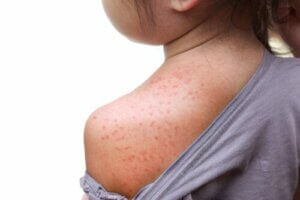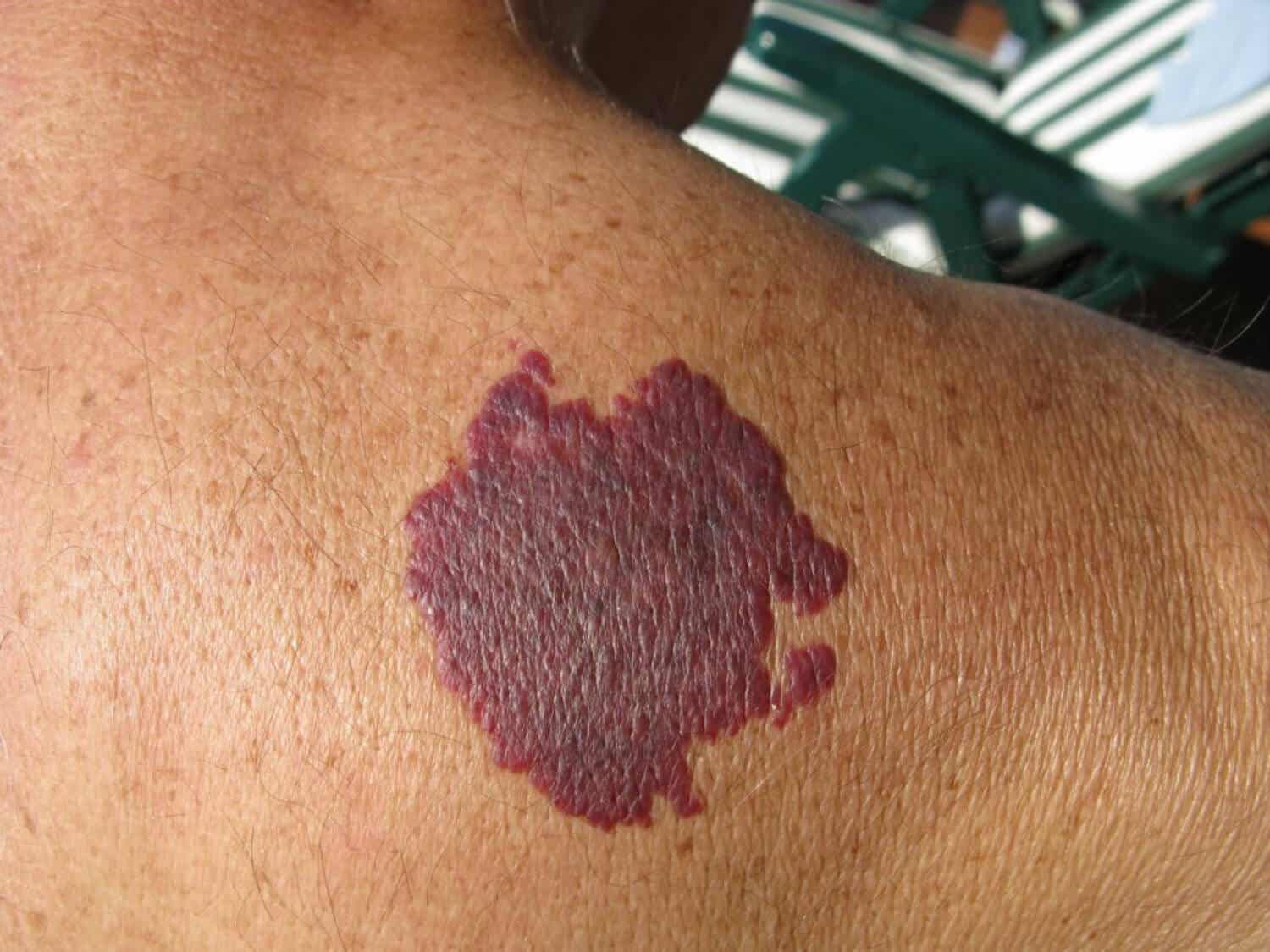Henoch-Schönlein Purpura in Children

Henoch-Schönlein purpura is the most common vasculitis in children. Vasculitides are diseases in which blood vessels throughout the body become inflamed. Although it can affect anyone, it’s most common in younger children.
This problem usually goes away without complications. Even so, in some cases, it can create repercussions. Therefore, we’ll tell you everything you need to know about this disease in children.
What is Henoch-Schönlein purpura?
As mentioned above, Henoch-Schönlein purpura is the most common vasculitis in children. Vasculitis is a group of diseases in which the body’s immune system attacks its own blood vessels. As a result, these become inflamed.
In the case of Henoch-Schönlein purpura, the vessels that are most affected are the small vessels, especially the vessels of the child’s digestive tract, skin, and kidneys.

You may be interested in: Hip Synovitis in Children: What You Need to Know
What symptoms does it produce?
As in most diseases, the symptoms aren’t the same for all the people who present it. They’ll vary in intensity and won’t always be the same from one person to another. They’re all related to damage to the blood vessels. Thus, the most common symptoms of Henoch-Schönlein purpura are the following:
- Purpuric rash. These are red spots that appear on the skin. They’re elevated in comparison to the surrounding skin, so they’re noticeable to the touch upon physical examination. Although they can appear anywhere on the body, their most typical presentation is on the child’s legs and buttocks.
- Abdominal pain. The abdominal pain that appears is similar to that of infantile colic. It occurs around the navel and maybe more acute after meals. In addition, it’s sometimes accompanied by nausea and vomiting and even the appearance of blood in the stool.
- Inflammation and pain in the joints. Most commonly, a few large joints, such as the ankles and knees, are affected. Children, especially young children, may refuse to walk because of the pain.
- Kidney involvement. As the blood vessels that support it are damaged, the kidneys, which is a sensitive organ, may suffer consequences in their function.
Outbreaks usually last about four weeks and may recur for months or years in the child.
What is the prognosis of Henoch-Schönlein purpura?
Most often, after an outbreak or the recurrence of a few outbreaks, this disease eventually disappears spontaneously, even without treatment. However, there are occasions when some complications may occur in the course of the disease.

You may be interested in: Causes of Swollen Glands in Children
Diagnosis and treatment
In most cases, the presentation of this disease is very characteristic. This means that the specialist will only need a good clinical history and a correct physical examination to establish the diagnosis. On rare occasions, it’s necessary to perform further complementary tests.
It’ll be the doctor who decides what’s the most appropriate treatment for each case. In general, this is usually symptomatic. It’ll consist of analgesics and anti-inflammatory drugs in doses appropriate for each child until the symptoms are resolved. In some cases, it’ll be treated with other drugs, such as corticosteroids.
Regarding Henoch-Schönlein purpura in children, you should know…
This isn’t an uncommon pathology, especially during winter months and after the child suffers viral infections, such as a cold or pharyngitis. In spite of this, it’s not a serious disease and it usually resolves itself, even without treatment, without leaving long-term effects.
Even so, as always, in case of any symptom or sign of alarm that makes you suspect any disease in your child, you should go to a specialist. The doctor will be the one to confirm the diagnosis and establish the most appropriate treatment according to each case.
Henoch-Schönlein purpura is the most common vasculitis in children. Vasculitides are diseases in which blood vessels throughout the body become inflamed. Although it can affect anyone, it’s most common in younger children.
This problem usually goes away without complications. Even so, in some cases, it can create repercussions. Therefore, we’ll tell you everything you need to know about this disease in children.
What is Henoch-Schönlein purpura?
As mentioned above, Henoch-Schönlein purpura is the most common vasculitis in children. Vasculitis is a group of diseases in which the body’s immune system attacks its own blood vessels. As a result, these become inflamed.
In the case of Henoch-Schönlein purpura, the vessels that are most affected are the small vessels, especially the vessels of the child’s digestive tract, skin, and kidneys.

You may be interested in: Hip Synovitis in Children: What You Need to Know
What symptoms does it produce?
As in most diseases, the symptoms aren’t the same for all the people who present it. They’ll vary in intensity and won’t always be the same from one person to another. They’re all related to damage to the blood vessels. Thus, the most common symptoms of Henoch-Schönlein purpura are the following:
- Purpuric rash. These are red spots that appear on the skin. They’re elevated in comparison to the surrounding skin, so they’re noticeable to the touch upon physical examination. Although they can appear anywhere on the body, their most typical presentation is on the child’s legs and buttocks.
- Abdominal pain. The abdominal pain that appears is similar to that of infantile colic. It occurs around the navel and maybe more acute after meals. In addition, it’s sometimes accompanied by nausea and vomiting and even the appearance of blood in the stool.
- Inflammation and pain in the joints. Most commonly, a few large joints, such as the ankles and knees, are affected. Children, especially young children, may refuse to walk because of the pain.
- Kidney involvement. As the blood vessels that support it are damaged, the kidneys, which is a sensitive organ, may suffer consequences in their function.
Outbreaks usually last about four weeks and may recur for months or years in the child.
What is the prognosis of Henoch-Schönlein purpura?
Most often, after an outbreak or the recurrence of a few outbreaks, this disease eventually disappears spontaneously, even without treatment. However, there are occasions when some complications may occur in the course of the disease.

You may be interested in: Causes of Swollen Glands in Children
Diagnosis and treatment
In most cases, the presentation of this disease is very characteristic. This means that the specialist will only need a good clinical history and a correct physical examination to establish the diagnosis. On rare occasions, it’s necessary to perform further complementary tests.
It’ll be the doctor who decides what’s the most appropriate treatment for each case. In general, this is usually symptomatic. It’ll consist of analgesics and anti-inflammatory drugs in doses appropriate for each child until the symptoms are resolved. In some cases, it’ll be treated with other drugs, such as corticosteroids.
Regarding Henoch-Schönlein purpura in children, you should know…
This isn’t an uncommon pathology, especially during winter months and after the child suffers viral infections, such as a cold or pharyngitis. In spite of this, it’s not a serious disease and it usually resolves itself, even without treatment, without leaving long-term effects.
Even so, as always, in case of any symptom or sign of alarm that makes you suspect any disease in your child, you should go to a specialist. The doctor will be the one to confirm the diagnosis and establish the most appropriate treatment according to each case.
All cited sources were thoroughly reviewed by our team to ensure their quality, reliability, currency, and validity. The bibliography of this article was considered reliable and of academic or scientific accuracy.
- Wedgwood, R. J. P., & Klaus, M. H. (1955). ANAPHYLACTOID PURPURA (SCHÖNLEIN-HENOCH SYNDROME). Pediatrics, 16(2).
- Nielsen, H. E. (1988). Epidemiology of Schonlein-Henoch purpura. Acta Paediatrica Scandinavica, 77(1), 125–131. https://doi.org/10.1111/j.1651-2227.1988.tb10610.x
- Protocolos • Púrpura de Schönlein-Henoch. (n.d.). Retrieved June 30, 2020, from www.aeped.es/protocolos/
This text is provided for informational purposes only and does not replace consultation with a professional. If in doubt, consult your specialist.








